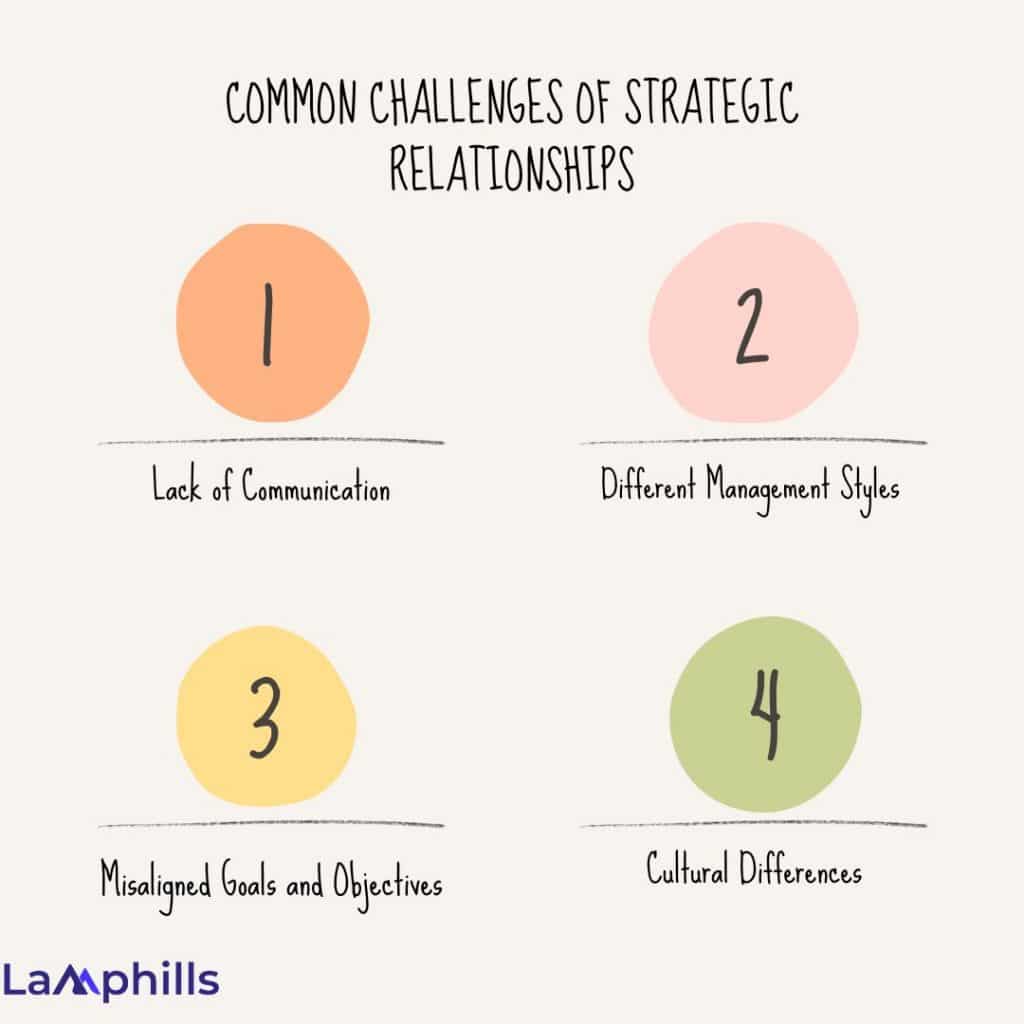It’s a known fact that Strategic Relationship Building and Strategic Relationship Management have become essential for driving growth, enhancing brand reach, and ensuring long-term success. But what exactly are strategic relationship, and how can they be used effectively? If you’ve ever wondered how businesses navigate such alliances and why they prioritize these relationships, you’re not alone. These relationships aren’t just about collaboration—they are about crafting and executing strategies that lead to mutual success and shared value. In this article, I guide you through steps for building strategic relationships, the importance of strategic relationships, and some common challenges of strategic relationship.
Key Points
- Most strategic relationships involve non-competing businesses that complement each other’s strengths.
- Strategic relationships can sometimes involve exclusive rights or access to resources, markets, or intellectual property. These alliances ensure that both parties benefit from unique opportunities, often leading to significant competitive advantages.
- Beyond simple collaboration, these partnerships often include mergers, acquisitions, joint ventures, and financing.
- They are designed to align with long-term strategic goals, offering pathways for scaling operations, accessing new markets, or diversifying products and services.
What Is the Meaning of Strategic Relationship?
A strategic relationship refers to a formal, long-term alliance between two or more entities that collaborate to achieve common goals and objectives. This collaboration can involve sharing resources such as finances, expertise, intellectual property, or technology. The aim is to leverage each party’s strengths to enhance their competitive position, create new opportunities, and drive collective success. Strategic relationships are often built between non-competing businesses that can complement each other’s capabilities, allowing each partner to access new markets, resources, or technology that would otherwise be out of reach.
Examples of strategic relationship includes joint ventures, alliances, partnerships, and mergers. In these relationships, the entities work together on mutual projects or goals, share the risks and rewards, and gain advantages such as exclusive market access or technological collaborations. The essence of a strategic relationship is that it adds value to all parties involved, fostering long-term growth and creating sustainable competitive advantages.
How to Build a Strategic Relationship
Building a strategic relationship requires intentional effort, long-term thinking, and an understanding of how both parties can benefit. Strategic relationship management and strategic relationship building are essential for maintaining and fostering partnerships that help organizations thrive. Below are the steps on how to build these relationships effectively:
#1. Start Early and Define Clear Objectives
One of the key aspects of strategic relationship management is starting the process early. Relationships take time to develop, and having a clear set of goals helps ensure that both parties benefit. Before entering into a relationship, identify your specific needs—whether it’s market expansion, financial support, or technological expertise. By defining these objectives, you are better positioned to identify the right partners. For instance, if your business needs distribution support, connecting with supply chain experts would be a strategic move.
Examples of Strategic Relationship: A small startup in the tech industry seeking marketing expertise partners with a well-established marketing firm, creating mutual growth opportunities.
#2. Develop a Well-Defined Relationship Strategy
Strategic relationship building doesn’t happen by accident. It requires a deliberate approach, where every move is part of a larger plan. Start by creating a strategy for how you will manage these relationships, including your desired outcomes, potential partners, and a plan to track progress. This may closely resemble a stakeholder engagement plan, where you map out who you need to engage with and how you will provide and receive value over time.
Key elements of this strategy should include methods of engagement, available resources, and metrics to assess success. Strategic relationship management relies on consistency, so having a clear plan ensures that no opportunities are missed.
#3. Tailor Communication to Each Partner’s Needs
Effective communication is vital in strategic relationship building. Each partner will have different communication preferences, business goals, and cultural contexts. This means you need to tailor your approach to fit the unique needs of each relationship. Understanding their pain points, goals, and the value they seek helps in crafting a message that resonates. Strategic relationship management requires you to be flexible—whether that means adjusting the frequency of communication or tailoring your message to fit a particular partner’s style.
Cultural awareness is especially important when dealing with international partners. For instance, a business in India may prefer building a personal relationship before engaging in formal discussions, while an American firm might be more comfortable with direct and formal communication.
#4. Provide Mutual Value Consistently
At the core of every strategic relationship is mutual benefit. Offering value consistently to your partners ensures that the relationship remains strong. Whether it’s through offering insights, making introductions, or sharing resources, the key is to give as much as you receive. This deepens the trust and strengthens the relationship.
As you build trust, your partner is likely to reciprocate, offering benefits beyond what is written in contracts. Examples of strategic relationship: A clothing brand collaborating with a fabric supplier to innovate eco-friendly materials that benefit both businesses.
#5. Use Tools to Manage and Track Relationships
Technology plays a significant role in strategic relationship management. Using tools like CRMs or specialized relationship management software helps you track communications, key milestones, and the progress of each relationship. These platforms offer features such as stakeholder mapping, issue tagging, and task management.
Tracking relationships ensures that everyone in your organization is aware of the status of each partnership, minimizing the risk of losing valuable connections due to personnel changes or lack of communication. Examples of strategic relationships: A nonprofit organization using CRM tools to maintain and manage its relationships with donors, ensuring regular updates and consistent engagement.
#6. Nurture Relationships and Honor Commitments
Once a strategic relationship is established, nurturing it is vital. Strategic relationship building is not a one-time effort; it requires continuous effort to keep the relationship healthy and fruitful. Staying in regular contact, checking in on your partner’s evolving needs, and honoring your commitments are all part of this process. It’s about maintaining a positive working relationship and providing long-term value.
Benefits of strategic relationships
The benefits of strategic relationship building and management include:
#1. Access to New Customers
Strategic relationship management is essential for accessing new customers. By partnering with businesses that have a complementary product or service offering, you can tap into their existing customer base. This approach allows for leveraging established trust and goodwill, making it easier for both partners to attract new clients who are already familiar with the partner’s offerings.
#2. Reach New Markets and Sectors
Engaging in strategic relationships can provide the means to penetrate new markets and sectors. Collaborating with partners who have expertise in specific areas allows you to capitalize on their knowledge and networks. This can be especially valuable in unfamiliar industries, as it mitigates the risks associated with market entry, giving both parties a foothold in diverse sectors.
#3. Boost Brand Awareness and Trust
Strategic relationship building enhances brand awareness and credibility. By aligning with reputable partners, you increase your visibility and strengthen customer trust. This collaborative approach not only broadens your market reach but also positions your brand as a key player in your industry, fostering a more substantial reputation among potential clients.
#4. Expand Geographic Reach
A strategic relationship can facilitate expansion into new geographic regions. Working with local partners who possess in-depth knowledge of their markets allows for a smoother transition into unfamiliar territories. This localized presence can enhance customer comfort, making it easier to establish trust and credibility in new locations without substantial investment.
#5. Shared Resources and Expertise
Strategic partnerships allow for the sharing of valuable resources and expertise, driving innovation and efficiency. By pooling strengths and capabilities, businesses can tackle complex challenges collaboratively. This synergistic approach not only enhances operational capabilities but also fosters a culture of innovation that can lead to improved product offerings and services.
#6. Increase Sales and Revenue
Strategic relationship management is instrumental in driving sales and revenue growth. By collaborating on marketing and sales initiatives, partners can enhance their value propositions and broaden their customer outreach. This partnership-driven approach can lead to increased sales volumes and stronger customer engagement, ultimately contributing to higher profitability.
#7. Enhanced Customer Retention and Loyalty
Building strategic relationship can significantly improve customer retention and loyalty. By offering a more comprehensive suite of products and services through partnerships, you enhance the value delivered to your customers. This holistic approach not only meets diverse customer needs but also strengthens loyalty, making it less likely for clients to seek out competitors.
Common Challenges of Strategic Relationships

When it comes to strategic relationship management and strategic relationship building, there are several inherent challenges that businesses often face. These challenges can create friction and affect the overall success of a partnership if not properly managed. Some of these challenges include:
#1. Lack of Communication
One of the primary challenges in strategic partnerships is the absence of effective communication. Without clear, open channels, misunderstandings can occur, leading to misalignment of goals and efforts. Strategic relationships thrive on transparency, but often, partners may not invest enough in regular updates or honest discussions about their expectations. As a result, critical issues may go unresolved, impacting the relationship’s success.
#2. Different Management Styles
Strategic relationships bring together businesses that may have vastly different approaches to management and decision-making. These differences can manifest in how companies structure their teams, handle issues, or approach innovation. If these management styles clash, it can create confusion and reduce operational efficiency. Partners often struggle to reconcile these differences, which can lead to frustration on both sides.
#3. Misaligned Goals and Objectives
When businesses enter a strategic partnership, their objectives need to be aligned for the relationship to be mutually beneficial. However, it is not uncommon for partners to discover that their goals diverge as the relationship progresses. Misaligned goals, whether in terms of financial outcomes, market focus, or brand positioning, can lead to friction. This misalignment weakens the foundation of the partnership, making it harder to collaborate effectively.
#4. Cultural Differences
Strategic relationships often involve partnerships across geographic regions or industries, leading to cultural differences that affect day-to-day interactions. These cultural gaps may be reflected in communication styles, work ethics, and organizational values. If not addressed, these differences can cause misunderstandings and create barriers to collaboration, ultimately weakening the partnership.
Despite these challenges, strategic relationship management can overcome these obstacles through proactive planning. Establishing strong communication protocols, embracing flexible management styles, and regularly reassessing goals can help ensure the long-term success of the partnership. Additionally, fostering a deep understanding and respect for cultural differences strengthens collaboration, helping businesses build sustainable strategic relationships.
What Is Necessary for a Strategic Relationship to Be Successful?
Open communication lays the foundation for successful strategic partnerships, ensuring clarity of objectives, trust, and strong relationships. On the operational level, the most important group to involve, from both companies, is middle management since their objectives are often conflicting.
What Is the Key to a Successful Relationship?
Compromise and ongoing communication are key to respecting each other’s feelings, needs, and values. But compromise shouldn’t always be one way. If one partner actively disrespects, ignores, or demeans the other person, this is abusive behavior.
How Will You Apply Relationship Marketing in Your Business?
Solicit customer feedback using polls, surveys, and calls, which induces a positive impression that you value customer opinions to create better products and services. Provide over-the-top customer service to consistently impress consumers and create a sense of loyalty.
What Is the Role of a Strategic Relationship?
Strategic partnerships are based on trust and respect. An EA who is a strategic partner works in tandem with their executive and understands how to execute their vision and plans. They are also able to command respect as the “right-hand person” for their leader
What Are the Power of Strategic Relationships?
A strategic partnership enables companies to penetrate new markets more effectively by leveraging their partners’ local proprietary knowledge, distribution channels, and customer relationships.
What Is a Key Strategic Partner?
A strategic partnership represents the pinnacle of the relationship between an executive and their assistant, characterized by a profound level of trust, respect, and collaboration. This synergy is where many aspire to be, yet not all relationships reach this depth due to various challenges.
What Is a Strategic Partner Example?
One prominent example of a successful strategic partnership is the partnership between Apple and Nike. This collaboration brought together Apple’s technological expertise and Nike’s extensive knowledge in sports and fitness.
Conclusion
In conclusion, strategic relationships are essential for maximizing marketing strategies and driving business growth. By focusing on strategic relationship management and strategic relationship building, companies can enhance their market presence, access new customer bases, and build long-term brand loyalty. These relationships provide the tools necessary to succeed in an increasingly competitive market while driving profitability and growth.
Related Articles
- How to Leverage Client Testimonials for Stronger Customer Relationships
- STRATEGIC PUBLIC RELATIONS: Examples of Objectives With Personal Insights
- Understanding LinkedIn SSI Score: What It Is and How You Can Improve It
- Niching Down: A Guide to Finding Your Business’s Specialized Focus






